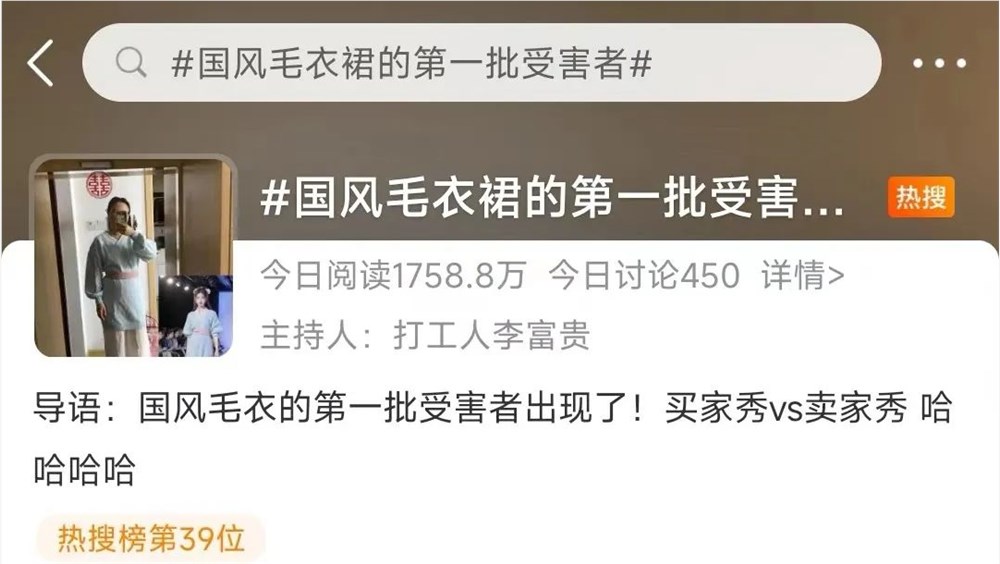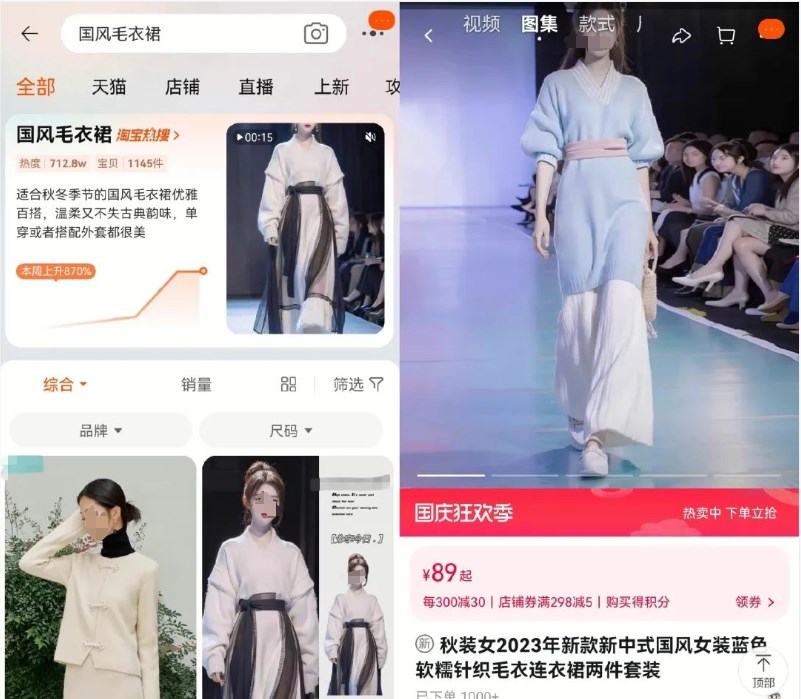Selling Thousands with Just an AI Image? Netizens Scammed by Chinese-Style Knit Dresses
-
The number of 'victims' of Chinese-style knit dresses continues to rise.
The seller's display features a new Chinese design, with the knitwear appearing soft and flowing, and the models resembling graceful noblewomen. However, the buyer's reality turns out to be more like a lowly servant—colors, cuts, and materials are far from the advertised effect.
Recently, the topic 'First Victims of Chinese-Style Knit Dresses' trended across major platforms, with over 34.04 million views on Weibo and 130 million video plays under the 'Chinese-Style Knitwear' hashtag on Douyin.

A search for 'Chinese-style knit dresses' on Taobao shows 1,145 related products, with weekly popularity reaching 7.128 million. High-selling items have already surpassed 1,000 orders.

Yet, very few buyer reviews match the seller's display. Douyin fashion blogger 'Sponge Beibei's Cute Little Belly' posted two review videos on Chinese-style knit dresses, commenting, 'Great design, but please don’t design it again,' which garnered 86,000 likes.
Why do these seemingly beautiful Chinese-style knit dresses turn into 'rags' once worn?
After being alerted by netizens, some buyers realized these weren't actual runway photos but AI-generated renderings - the traditional-style knit dresses shown didn't exist in reality. Merchants were using AI images for pre-sale production.
AIGC applications in e-commerce have been gradually expanding. As previously mentioned, the viral little green dress also became popular through AI images before being manufactured. Now it's the traditional-style knit dress's turn - why did this backfire so quickly? Will consumers continue to purchase AI-designed clothing?
Buyer Photos vs Seller Listings: AI Traditional Knit Dress Fiasco
With autumn fashion releases underway and increased attention on seasonal outfits, combined with the current popularity of Hanfu and traditional styles, these knit dresses had a ready audience.
According to monitoring of the "traditional knit dress" keyword, since early September, AI images of these dresses have gone viral on Xiaohongshu, Douyin, Kuaishou, and Bilibili. The original sources are hard to trace, and most popular posts didn't disclose the use of AI technology, with no platform warnings provided.
The most viral was a blue dress with a pink belt, receiving over 30,000 likes on Xiaohongshu, with many users asking where to buy it.
Unlike the little green dress, these traditional knit dresses used photorealistic AI models, making them more convincing. Users unfamiliar with AI images might not recognize them as synthetic, with some mistaking them for designer runway pieces with Photoshop alterations.
Creating physical garments based on a single image is more difficult with realistic AI designs than with anime-style illustrations, as designers have less room for creativity and the final product may deviate more from the design.
Some fashion-savvy users anticipated the issue of mismatched expectations: "It seems very picky about the wearer," "Only fair-skinned, beautiful, and slim people can pull it off," "Regular sweaters can't achieve this texture."
In reality, buyers of various body types have shared their experiences, showing that whether they're curvy or slim, the outfits fall short of the ethereal look of AI models.
According to observations by "Top AI Players," Chinese-style knitted dresses sold on platforms like Taobao, Douyin, Xiaohongshu, and Pinduoduo often feature only AI-generated images without actual product photos or detailed shots, with many reviews being fake. Among six stores consulted, all claimed their images were real photos, with one stating they were original designs from a factory and another sourcing from Guangdong.
The first wave of buyers became "victims," and after their disappointing experiences sparked discussions, more influencers joined in reviewing the products. However, due to prolonged pre-order delays or mismatched descriptions leading to returns, the second wave of buyers received refunds and even profited, becoming "beneficiaries."
Fashion reviewer "Muddy Beauty (133 lbs version)" shared that she spent over 2,000 yuan on eight Chinese-style sweaters, waited 20 days to receive just one set, and encountered issues at every step. However, late delivery compensations of 3–5 yuan per order netted her a 28-yuan profit.
Fashion designer "Modern Tailor" explains that while these new Chinese-style dresses may appear simple in design, the details are challenging to execute. From yarn selection to pattern-making and final production, she estimates needing at least three revisions. Her design has been in progress for nearly a month without being listed yet.
The AI-generated images of Chinese-style knitwear are achievable, but the process requires repeated refinements.
Many accounts selling these Chinese-style knitwear dresses appear to have been created in bulk within a short period. They first publish AI-generated images or videos of the dresses, then attach links to identical clothing items or privately message users with store names. The stores uniformly use AI images, with prices ranging from 60 to 300 yuan.
Qianqian, a fashion design student, shared that recreating the light and fluffy knitwear texture seen in AI images would cost significantly more than one or two hundred yuan based on her procurement experience.
Are Merchants Using AI to Deceive Consumers, Potentially Constituting False Advertising?
The core issue lies in the significant disparity between the advertised images and the actual products. Sellers deliberately conceal that the Chinese-style knitwear images are AI-generated, and many consumers fail to recognize this.
Recently, platforms such as WeChat Official Accounts, Douyin, and Bilibili have strengthened their regulation of AI-generated content (AIGC), requiring creators to label videos containing AI-generated content.

The 'Interim Measures for the Management of Generative Artificial Intelligence Services' also emphasizes that providers of generative AI services must label AI-generated images, videos, and other content in accordance with the 'Regulations on the Management of Deep Synthesis of Internet Information Services.'
For example, sellers of Chinese-style knit dresses did not actively label their product images and descriptions as AI-generated, leading to misunderstandings among users unfamiliar with AI. These users, expecting real photos, placed orders with high expectations, only to end up returning the products and becoming 'victims.'
Upon closer inspection, obvious flaws in the images can be spotted, such as extra fingers, blurred faces, incoherent background text, and unnatural facial features of the models.
However, we cannot expect every consumer to have a keen eye for spotting AI-generated images at a glance—this is the responsibility of merchants and platforms.
Merchants attempting to pass off AI-generated model images as real can distort consumers' rational judgment of product details. Some consumers have even filed complaints with platforms, arguing that using only AI-generated images to sell clothing constitutes fraudulent behavior.
So, does the use of AI images in advertising and marketing constitute false advertising?
According to Legal Daily, Professor Sun Ying from China University of Political Science and Law stated that AI fashion models inherently damage consumers' right to know and right to choose by failing to accurately represent product appearance, style, color, and patterns. This violates merchants' obligation to provide comprehensive, truthful product information and may constitute misleading advertising.
The interim measures require merchants and platforms to clearly label AI-generated model images and product photos, informing buyers about differences from actual items while properly resolving related consumer disputes.
AI-generated viral images can monetize traffic but e-commerce implementation remains immature
For merchants and creators, mass-producing AI fashion images to attract traffic for advertising or paid courses is feasible due to low costs. However, integrating AI visuals with production and e-commerce processes remains underdeveloped in the apparel industry.
AIGC practitioner Xiao Xue notes that while AI images can go viral, sustained success requires professional marketing teams and supply chain support - far more complex than content creation. B2B clients won't adopt this model long-term due to unclear commercial viability and weak monetization pathways.
Unlike recreational AI art users, brands and e-commerce sellers demand higher precision and controllability from AI-generated visuals.
Qianqian shared that it takes her about a week to complete a series of design sketches. She starts by determining the overall color palette and style of the clothing collection, then sketches the silhouettes, refines the overall look, adds colors, and finally incorporates decorative details.

Design Example
From design sketches to finished garments, the process typically involves pattern making, fabric selection, and sewing. Pattern making is a crucial step where designers use muslin on a dress form to realize their designs, marking adjustments to ensure precise measurements. Even a slight error in measurement can significantly impact the final product's appearance.
However, turning AI-generated trendy designs into sellable garments involves considerable uncertainty. Businesses must produce high-quality products before the trend fades. Rushing to replicate designs without ensuring quality can lead to higher return rates and significant inventory risks. For small businesses or those without experience in the fashion e-commerce industry, leveraging AI for quick profits can be quite risky.
Currently, in the early stages of large model development, there is a growing number of vertical industry applications, such as SaaS-based generative AI products and toolkits for e-commerce. These tools offer functionalities like AI model outfit changes, AI background generation, and AI marketing copy creation. Businesses can use AI tools to gain inspiration, quickly generate trending designs, and thereby shorten design cycles while improving production efficiency.
Using AI to enhance product or model photos based on actual shots tends to yield more controllable results, with details closely matching the original images. However, creating entirely new garments like the little green dress or the Chinese-style knit dress from scratch often makes it difficult to quickly replicate AI's innovative designs. As a result, this production model has yet to become mainstream in the fashion industry.
Fang Zhihao, a researcher at AIGC content creation platform Wujie AI, revealed to "Internet Vernacular" that current client demands primarily fall into three categories:
- Small and medium-sized sellers on e-commerce platforms who need clothing displays and cover images for their storefronts.
- Brands like Semir that have already integrated AI into their workflows.
- Major brands with specific requirements, such as Korean-style fashion, which necessitates training specialized vertical models.
"Fashion is the most common application, especially among women's clothing brands, particularly e-commerce sellers concentrated in the Xiaoshan area," Fang admitted. "Actually, AI-generated women's fashion images present relatively greater challenges due to numerous details like lighting, folds, etc." Wujie AI is currently researching the "three niches" (Hanfu, Lolita fashion, JK uniforms), with special focus on generating Chinese-style clothing images.
The market is pragmatic. As Xiaoxue mentioned, when AIGC can meet 80% of existing demands with favorable cost-effectiveness, it will rapidly proliferate across industries without needing viral attention.
